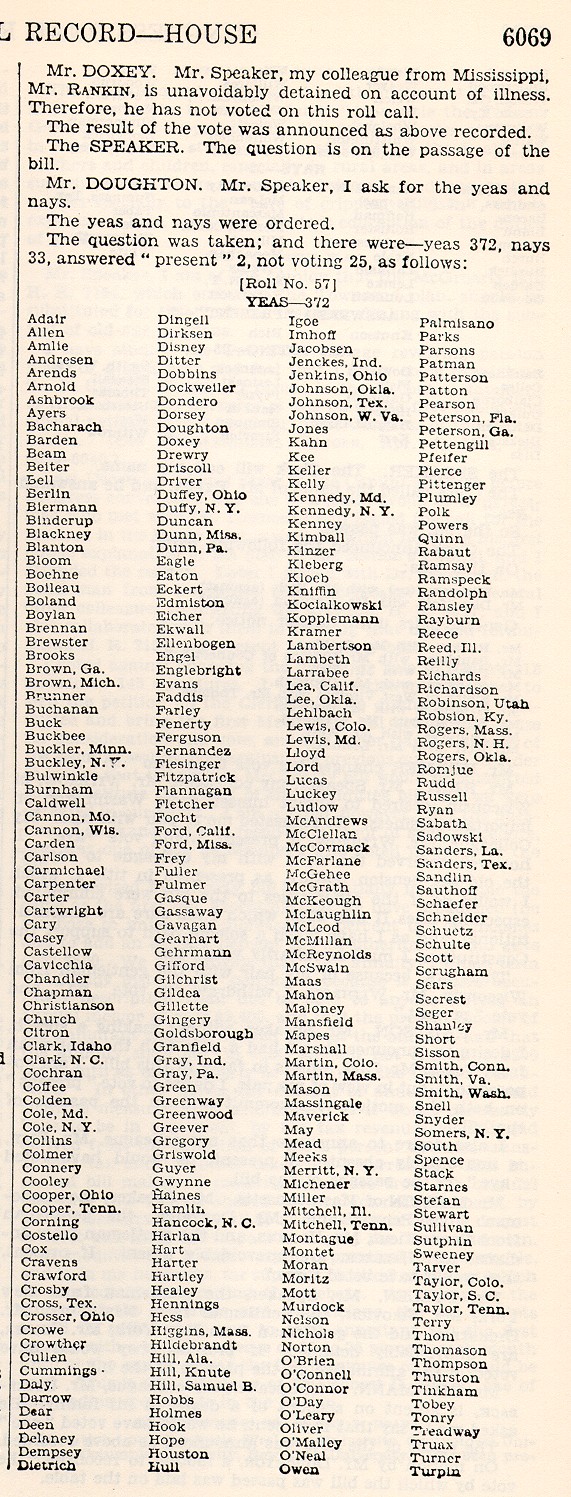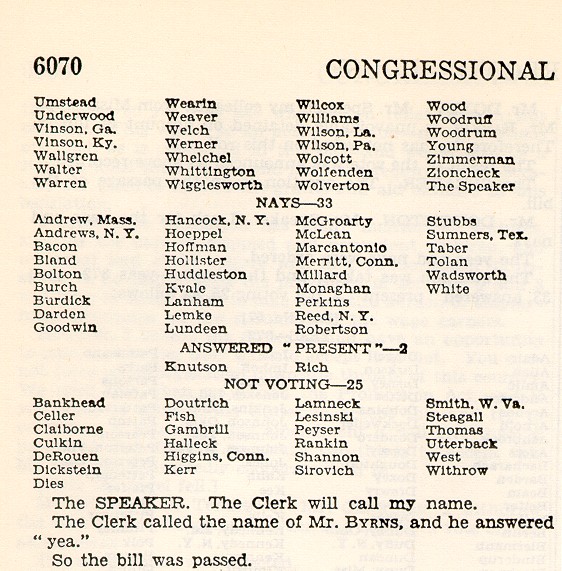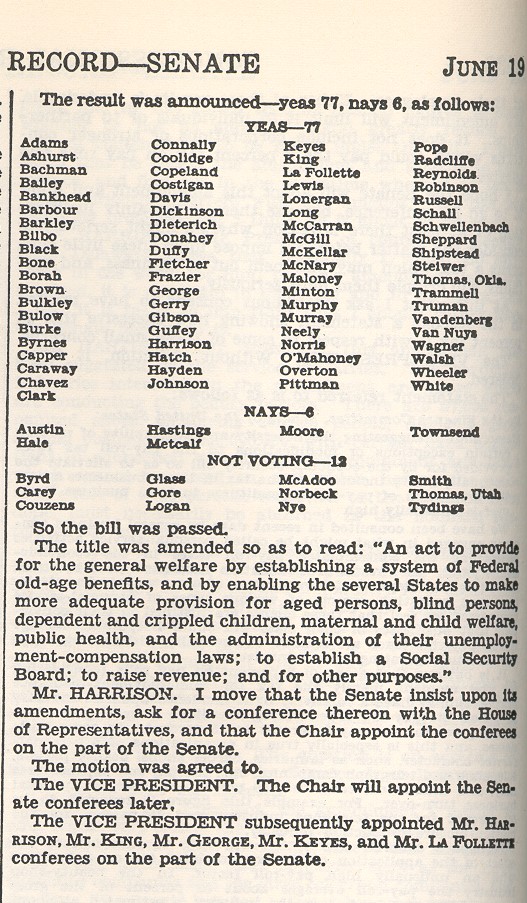Skip to comments.
Vote Tallies (1935 "Economic Security Bill" renamed "Social Security Act" Gee, thanks RATS!)
SSA.gov ^
| 5/20/08
Posted on 05/20/2008 6:56:38 PM PDT by Libloather
Vote Tallies
1935 Social Security Act
Proposal Introduced in Congress
Shortly after the 74th Congress convened in January 1935, President Roosevelt sent his "Economic Security Bill" to Capitol Hill. The Administration proposal was transmitted to the Congress on January 17, 1935 and it was introduced that same day in the Senate by Senator Robert Wagner (D-NY) and in the House by Congressman Robert Doughton (D-NC) and David Lewis (D-MD). The bill was referred to Senate Finance Committee and the House Ways & Means Committee.
Hearings
The House Ways & Means Committee held hearings on the bill from January 21, 1935 through February 12, 1935. The Senate Finance Committee held hearings from January 22, 1935 through February 20, 1935.
Renamed the "Social Security Act"
During a Ways & Means meeting on March 1, 1935 Congressman Frank Buck (D-CA) made a motion to change the name of the bill to the "Social Security Act of 1935." The motion was carried by a voice vote of the Committee.
Committee Reports & Initial Passage
The Ways & Means Committee Report on the Social Security Act was introduced in the House on April 4, 1935 and debate began on April 11th. After several days of debate, the bill was passed in the House on April 19, 1935 by a vote of 372 yeas, 33 nays, 2 present, and 25 not voting. (This vote took place immediately followed a vote to recommit the bill to the Committee, which failed on a vote of Yea: 149; Nay: 253; Present: 1; and Not Voting: 29.)
The bill was reported out by the Senate Finance
Committee on May 13, 1935 and introduced in the Senate on June 12th. The debate lasted until June 19th, when the Social Security Act was passed by a vote of 77 yeas, 6 nays, and 12 not voting.
Conference Report & Final Passage
Due to differences between the House and Senate versions, the legislation then went to a Conference Committee which met throughout the month of July. Final Congressional action on the bill took place when the Conference Report was passed by voice vote on August 8, 1935 in the House and on August 9th in the Senate.
Signed Into Law
On August 14, 1935 President Roosevelt signed the bill into law at a ceremony in the White House Cabinet Room.
TOPICS: Crime/Corruption; Editorial; Government; News/Current Events
KEYWORDS: 1935; security; social; socialism; socialsecurity; vote
Just how many of these 'lawmakers' knew that this Big Gubmint program would go bankrupt? Can we sue their families?
Congressional Vote Totals By Party
HOUSE (4/19/35) Democrats, Republicans, Farm Labor, Progressive/Other
Yes 284 81 1 6
No 15 15 2 1
Not Voting 20 4 0 1
Present 0 2 0 0
SENATE (6/19/35) Democrats, Republicans, Farm Labor, Progressive
Yes 60 16 1 0
No 1 5 0 0
Not Voting 8 4 0 0



To: Libloather
Hmmm, read in history where Bismark did the same for Germany way back in the 1800’s .... Germany became the first nation in the world to adopt an old-age social insurance program in 1889, designed by Germany’s Chancellor, Otto von Bismarck. The idea was first put forward, at Bismarck’s behest, in 1881 by Germany’s Emperor, William the First, in a ground-breaking letter to the German Parliament. William wrote: “. . .those who are disabled from work by age and invalidity have a well-grounded claim to care from the state.”
Bismarck was motivated to introduce social insurance in Germany both in order to promote the well-being of workers in order to keep the German economy operating at maximum efficiency, and to stave-off calls for more radical socialist alternatives. Despite his impeccable right-wing credentials, Bismarck would be called a socialist for introducing these programs, as would President Roosevelt 70 years later. In his own speech to the Reichstag during the 1881 debates, Bismarck would reply: “Call it socialism or whatever you like. It is the same to me.”
The German system provided contributory retirement benefits and disability benefits as well. Participation was mandatory and contributions were taken from the employee, the employer and the government. Coupled with the workers’ compensation program established in 1884 and the “sickness” insurance enacted the year before, this gave the Germans a comprehensive system of income security based on social insurance principles. (They would add unemployment insurance in 1927, making their system complete.)
One persistent myth about the German program is that it adopted age 65 as the standard retirement age because that was Bismarck’s age. This myth is important because Germany was one of the models America looked to in designing its own Social Security plan; and the myth is that America adopted age 65 as the age for retirement benefits because this was the age adopted by Germany when they created their program. In fact, Germany initially set age 70 as the retirement age (and Bismarck himself was 74 at the time) and it was not until 27 years later (in 1916) that the age was lowered to 65. By that time, Bismarck had been dead for 18 years.
2
posted on
05/20/2008 7:25:36 PM PDT
by
SkyDancer
("I Believe In The Law Until It Interferes With Justice")
Disclaimer:
Opinions posted on Free Republic are those of the individual
posters and do not necessarily represent the opinion of Free Republic or its
management. All materials posted herein are protected by copyright law and the
exemption for fair use of copyrighted works.
FreeRepublic.com is powered by software copyright 2000-2008 John Robinson


